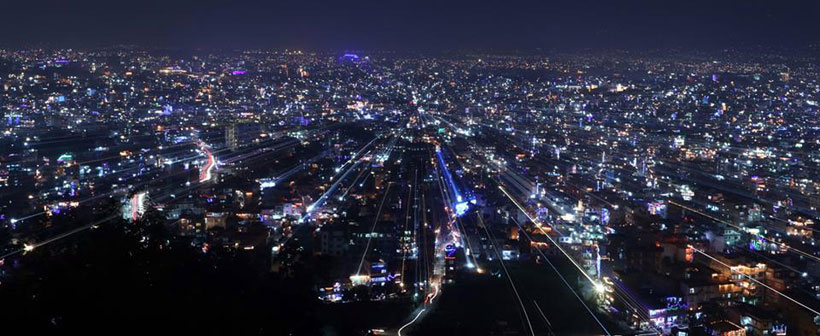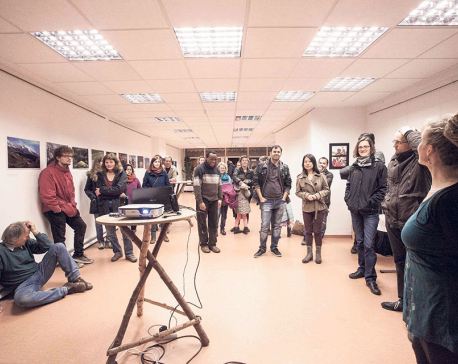
OR
A month without power outage
Changes felt in daily life
Published On: December 10, 2016 11:02 AM NPT By: Rudra Pangeni | @rudrapang

Businesses and factories report fall in operating costs
KATHMANDU, Dec 10: No load-shedding for a month has had a number of positive impacts in the lives of people, and industries and businesses have also felt relief from having to spend about three times more on diesel-produced electricity.
Factories and businesses have said their production has improved as they are operating confidently during the day time. People have changed their minds about buying inverters and saved money.
The general public has felt life a bit easier as they no longer have to worry about charging their mobile devices and do not have to schedule their daily work and life around load-shedding routines.
Continuous power supply took the public by surprise in the first week of November as the new management at Nepal Electricity Authority was successful in ending load-shedding for at least over four weeks in the Kathmandu Valley, and a significant drop in load shedding outside the valley. NEA has barred factories from operating for four hours during evening peak time.
Surendra Kumar Thakur, in-charge at Putalisadak-based New Shakya Workshop, said monthly expenditure had dropped by Rs 15,000 as he did not have to use diesel generators any more. The lack of power cuts allowed the workshop to do additional motorcycle servicings.
“We can now service over 20 motorcycles a day with the same manpower while the number was hardly 15 daily in November last past year,” Thakur said, adding that the firm can now also provide immediate services.
Aayushma Sharma, a resident of Imadol, changed her mind about buying an inverter for which she had set aside about Rs 10,000 early in November.
“It’s a great relief as the money has been saved and I also do not have to worry about electricity,” Sharma added.
The country had been importing inverters worth about Rs 3 billion annually.
There also a sharp drop in import of power back-up products like inverters and generator sets, importers said.
Nepal Electricity Authority blames inverters for consuming about 30 to 40 MW in the Kathmandu Valley while being recharged and NEA officials say that energy has now been saved.
Tej Narayan Kharel, the president of Federation of Electrical Entrepreneurs of Nepal, said inverter imports have tumbled by up to ten times while import solar-power systems halved November.
Sellers of electrical appliances said more power was being saved now as consumers had switched to more efficient LED bulbs from CFLs.
“Industries are now running fully in the day time, which was not possible in any year for over a decade and industrialists’ confidences have boosted,” Hari Bhakta Sharma, promoter of Deurali-Janta Pharmaceuticals Private Ltd, said. Sharma is also the president of the Confederation of Nepalese Industries (CNI).
Promoter of Arghakhanchi Cement Pvt Ltd and president of the Federation of Nepalese Chambers of Commerce and Industries said (FNCCI) Pashupati Murarka says his factories’ daily expenditure on diesel to generate electricity has come down to Rs 2,000 from Rs 7,000.
Sharma and Murarka said they appreciated the government’s effort in making no load-shedding possible for the time being but stressed on quality of electricity supply.
Industrialists are still in a wait-and-see mode about whether electricity supply in the driest months will continue and may expand their capacity once Nepal Electricity Authority announces end of load-shedding confidently.
NEA implemented its no load-shedding in the Kathmandu Valley as a test and announced substantial cuts in power outages.
Industrialists say factory units are now operating comfortably compared to the times of acute power crisis in the past. “The cost of production will be competitive once the power supply becomes permanently continuous,” CNI’s Sharma said.
You May Like This

Let's Write
The other day, we were having a discussion on how writing is a mental exercise, and how it should be... Read More...

Nepali daily life, culture, landscape in photographs
KATHMANDU, Nov 14: Nepali photographers have organized a two-week photo exhibition in Witzenhausen, Germany that began on November 11. The exhibition... Read More...

Rug weaving machine changes life of a woman in Sindhupalchowk
SINDHUPALCHOWK, July 11: Thirty eight years old Punu Tamang of Lisankhu, Pakhar-5, Jethal, was a simple laborer as early as... Read More...




Just In
- Govt receives 1,658 proposals for startup loans; Minimum of 50 points required for eligibility
- Unified Socialist leader Sodari appointed Sudurpaschim CM
- One Nepali dies in UAE flood
- Madhesh Province CM Yadav expands cabinet
- 12-hour OPD service at Damauli Hospital from Thursday
- Lawmaker Dr Sharma provides Rs 2 million to children's hospital
- BFIs' lending to private sector increases by only 4.3 percent to Rs 5.087 trillion in first eight months of current FY
- NEPSE nosedives 19.56 points; daily turnover falls to Rs 2.09 billion















Leave A Comment